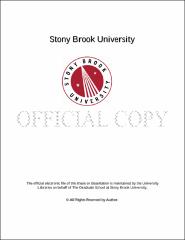| dc.identifier.uri | http://hdl.handle.net/11401/77392 | |
| dc.description.sponsorship | This work is sponsored by the Stony Brook University Graduate School in compliance with the requirements for completion of degree. | en_US |
| dc.format | Monograph | |
| dc.format.medium | Electronic Resource | en_US |
| dc.language.iso | en_US | |
| dc.publisher | The Graduate School, Stony Brook University: Stony Brook, NY. | |
| dc.type | Dissertation | |
| dcterms.abstract | Understanding how bacterial populations adapt in antibiotic environments has become important, given rising frequencies of antibiotic resistance. In this series of experiments, Escherichia coli are used to understand the mechanisms, timing, and selective forces that dictate how the populations adapt when exposed to the antibiotic streptomycin. We begin with a study of how antibiotic sensitive populations respond to antibiotics in an environment where the concentration of antibiotic grows from zero to above that which would normally kill E. coli cells. This was investigated via a novel system using continuous culture techniques. The results indicate that mutations giving resistance to streptomycin are present at low frequencies and immediately sweep to fixation once a threshold concentration of streptomycin is reached. However, resistance mutations of this kind are known to often have fitness costs. The compensatory mutation model holds that mutations that directly mitigate these losses in fitness will come into these populations quickly, raising mean fitness and allowing the resistant strains to successfully compete with their sensitive ancestors. In our experiments, no such direct compensation was found, even when investigated across numerous environments, growth conditions, and timescales. Rather, in all experiments, what was observed was an increase in fitness associated with adaptation to specific environmental conditions, just as would be expected in any experimental evolution experiment using antibiotic sensitive E. coli under similar conditions. This implies that after a population gains resistance to an antibiotic, there are little to no lasting negative effects for the population overall. | |
| dcterms.available | 2017-09-20T16:52:37Z | |
| dcterms.contributor | Eanes, Walter | en_US |
| dcterms.contributor | Dykhuizen, Daniel E | en_US |
| dcterms.contributor | TRUE, John | en_US |
| dcterms.contributor | Tonge, Peter. | en_US |
| dcterms.creator | Spagnolo, Fabrizio | |
| dcterms.dateAccepted | 2017-09-20T16:52:37Z | |
| dcterms.dateSubmitted | 2017-09-20T16:52:37Z | |
| dcterms.description | Department of Ecology and Evolution. | en_US |
| dcterms.extent | 136 pg. | en_US |
| dcterms.format | Application/PDF | en_US |
| dcterms.format | Monograph | |
| dcterms.identifier | http://hdl.handle.net/11401/77392 | |
| dcterms.issued | 2015-05-01 | |
| dcterms.language | en_US | |
| dcterms.provenance | Made available in DSpace on 2017-09-20T16:52:37Z (GMT). No. of bitstreams: 1
Spagnolo_grad.sunysb_0771E_12334.pdf: 8449632 bytes, checksum: 19364a18f41bb246a6b1f96b01eaa4e4 (MD5)
Previous issue date: 2015 | en |
| dcterms.publisher | The Graduate School, Stony Brook University: Stony Brook, NY. | |
| dcterms.subject | Biology | |
| dcterms.subject | Antibiotic Resistance, mutation, streptomycin | |
| dcterms.title | Mutation in Antibiotic Resistance: Rate and Fitness | |
| dcterms.type | Dissertation | |

